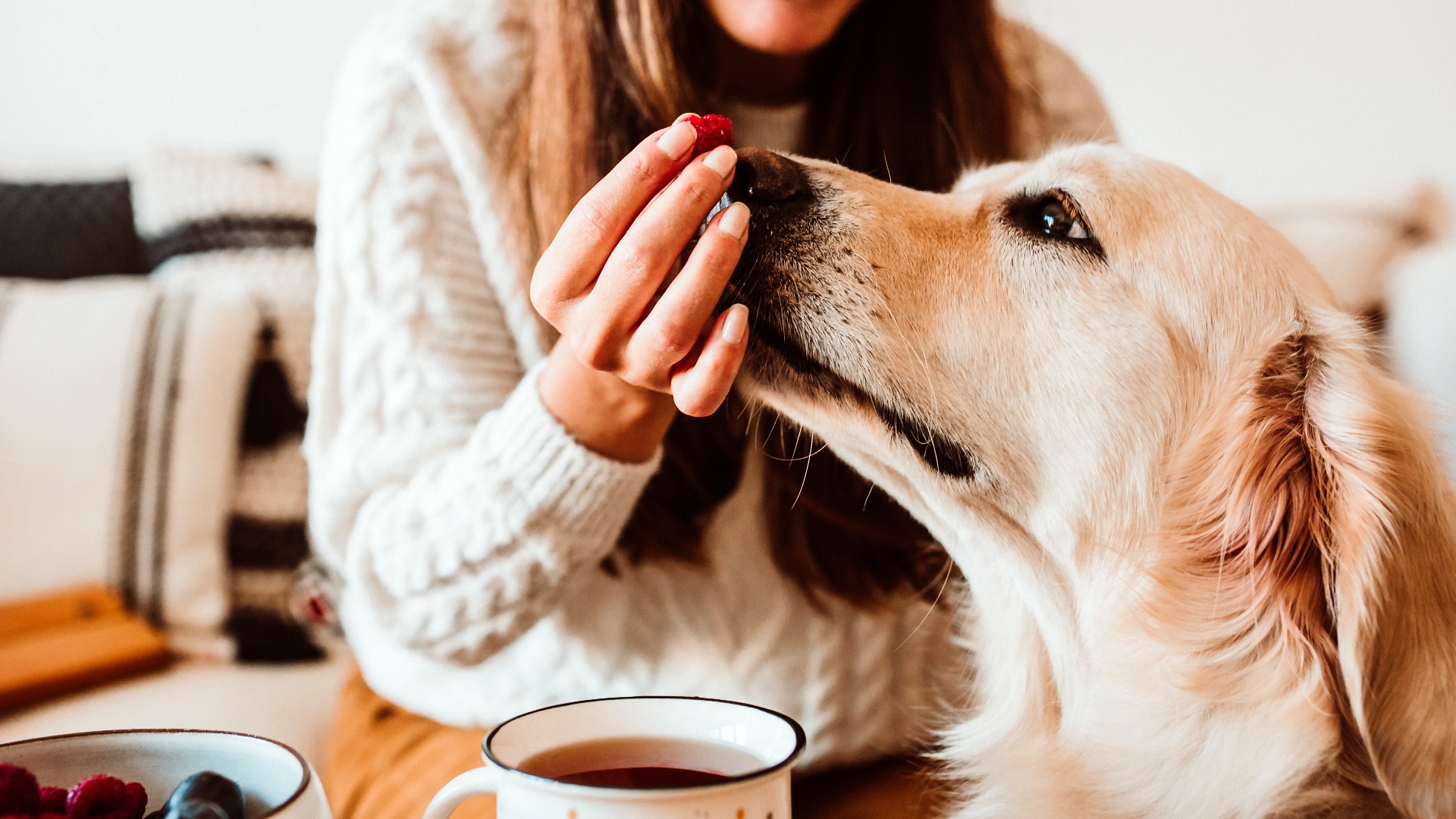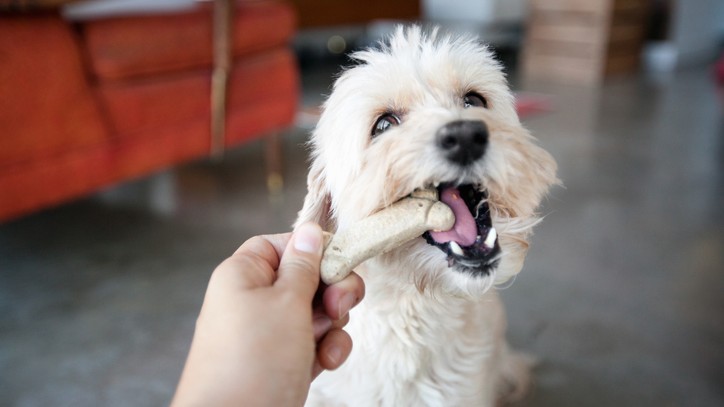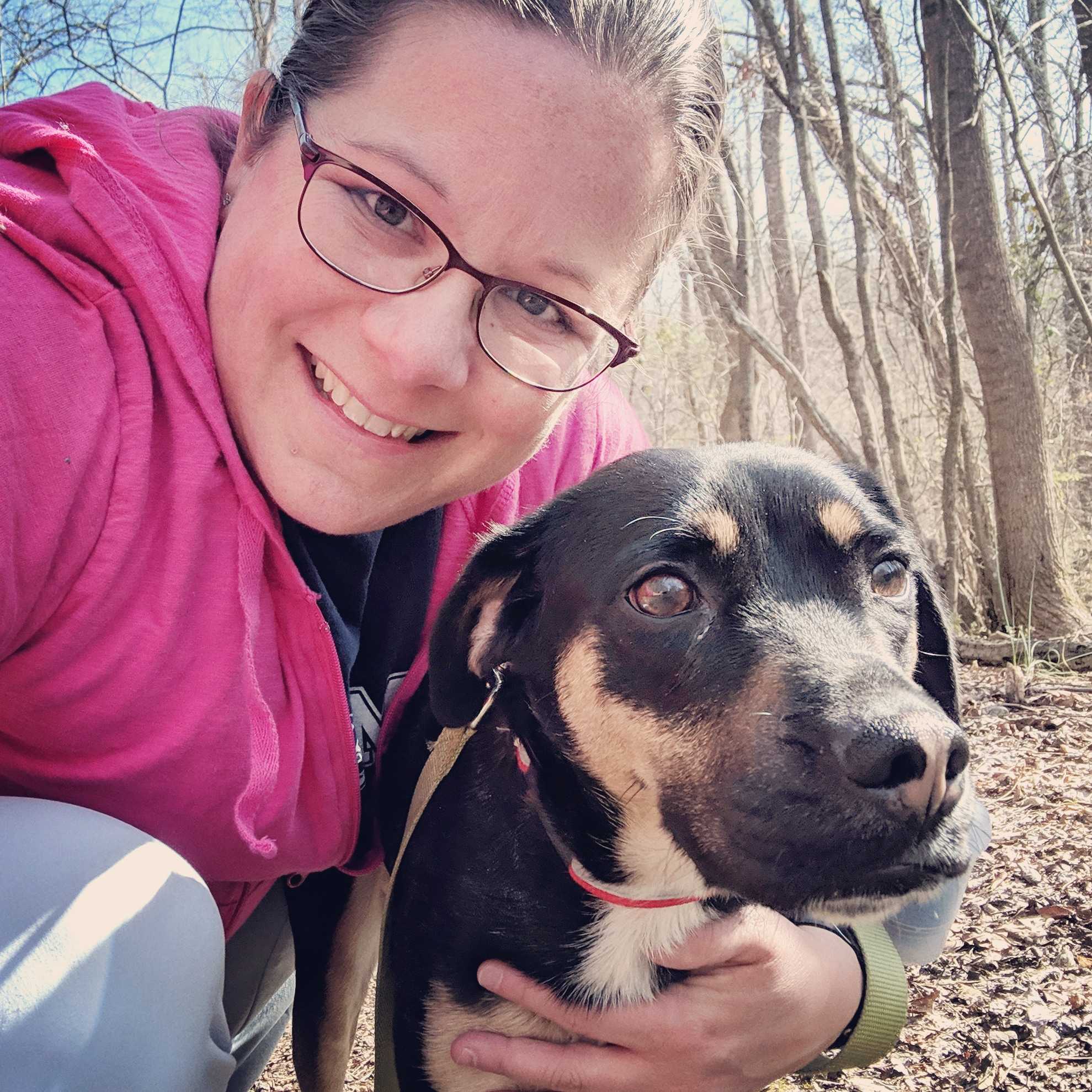How much should I feed my dog? Our vet answers
Like humans, pets are prone to obesity. Here’s how to help your dog maintain a healthy weight.

A common question, asked by dog owners in veterinary clinics every day, is “how much should I feed my dog?” And that's a great question! Maintaining your dog’s weight is an important component of keeping your dog healthy and your veterinarian can be an excellent source of nutrition information. Unfortunately, this seemingly simple question doesn’t necessarily have an easy answer.
Firstly, even when you pick from the best dog food available, dog foods can differ dramatically in caloric density. Think of this example from human nutrition: the number of calories in a cup of ice cream is dramatically higher than the number of calories in a cup of chopped carrots! No human dietician can tell you how much food you need to eat each day, because the quantity of food required varies considerably based on the foods’ caloric content. Similarly, the quantity of food that your dog needs to eat each day will vary dramatically based on the food’s caloric density.
Additionally, every dog has a slightly different metabolism. Your dog’s metabolism is influenced by a number of factors, including age, sex, activity level, and reproductive status. It’s impossible to determine how all of these factors will interact in any given pet; therefore, even after performing all of the “right” calculations, determining how much to feed your pet always requires some degree of trial and error.
- Can a dog be vegan? We asked a vet…
Are you overfeeding your dog?
While underfeeding and overfeeding are both possibilities in pet nutrition, it is far more common for well-intentioned owners to overfeed their dogs than to underfeed them. Between your dog’s daily meals and dog treats, many dogs receive far more calories than the amount needed to maintain a healthy weight. In fact, the majority of dogs in the United States are overweight or obese.
While obesity is a problem in and of itself, it can also lead to other serious health conditions. Obese dogs are more likely to develop arthritis, back pain, and other disorders of the musculosketal system. Obesity also predisposes affected dogs to other medical conditions, including heart disease, diabetes mellitus, cancer, and heat intolerance. Therefore, obesity doesn’t just impact a pet’s quality of life, it can also significantly decrease their lifespan.
If your dog is overweight, talk to your veterinarian about a weight loss program. It’s important to restrict your dog’s caloric intake in a safe way, because starting your dog on a crash diet without veterinary guidance can lead to nutritional deficiencies and other negative effects. If your dog is currently at a relatively healthy weight and you’re hoping to prevent weight gain, however, read on to learn how to ensure that your dog is eating an appropriate diet!
Reading dog food labels
Whether you're using dry dog food or wet dog food, every dog food container’s label should contain a section titled “Feeding Guidelines.” This section tells you how much of the diet your dog should eat per day, based on your dog’s weight. Label recommendations serve as a good starting guideline when determining how much to feed your dog. Keep in mind, however, that dogs are individuals. Like humans, individual dogs may vary significantly in their metabolic rate and their daily calorie requirements.
Additionally, a recent analysis of dog food label recommendations found that many labels are not entirely accurate, often overestimating how much food a dog actually needs. The dogs involved in feeding studies are often more active than a typical pet dog, receiving regularly scheduled exercise, and they may or may not be spayed or neutered like a typical pet dog. Therefore, in some cases, feeding the amount listed on the food label may result in overfeeding your pet.
Despite the limitations of this method, the label recommendations can serve as an excellent starting point when feeding your dog. There’s one caveat, though - be sure to use an accurate measuring cup when measuring your dog’s food! “One cup” means one cup as measured from a measuring cup, not an 8 oz. glass full of dog food! Additionally, be prepared to make adjustments based on how your dog responds to the diet.
Feed your dog according to the bag’s label recommendations for two to three weeks, then evaluate your dog’s weight. If your dog is gaining weight, decrease the quantity that you are feeding by approximately 10%. If your dog is becoming underweight or is losing weight at an excessively rapid pace, consider increasing the quantity that you are feeding by 10%. Making small adjustments every few weeks should help you gradually zero in on the quantity of food that allows your dog to maintain a healthy weight.

Calculating daily caloric intake
There are many ways to calculate your dog’s daily caloric requirements. Online calculators, such as the one found at the Pet Nutrition Alliance website, are probably the easiest way to determine your dog’s required daily caloric intake, reducing the risk of errors that can accompany manual calculations.
After calculating your dog’s daily caloric requirement, it’s time to see how many calories are in a cup (or can) of your dog’s food. This information can sometimes be found on the pet food label. You may see the phrase “kilocalories per cup” or “kilocalories per can. In this situation, kilocalorie is another word for a calorie and you can use this number in your calculations. If the calorie density is not listed on the label, you may need to do some detective work. Call the pet food manufacturer’s customer service line for accurate caloric density information, or look online to see if the food manufacturer has published this information.
Finally, divide your dog’s optimal daily caloric intake by the caloric density of the dog food. This will tell you exactly how many cups or cans of food your dog should eat per day, to meet his caloric needs. Remember that feeding this amount of dog food will meet all of your dog’s caloric needs; if you want to feed any treats, you will need to determine the caloric content of the treats and remove a corresponding amount of dog food from your dog’s daily meals.
Although this method may be more accurate than following the label recommendations, you should still be prepared to make adjustments to reflect your pet’s individual metabolism.
Monitor and adjust as needed
Regardless of how you determine your dog’s daily food intake, you should carefully monitor your dog’s weight so that you can make adjustments as needed. A dog that is at a healthy weight should have a tapered waist when viewed from above or from the side. You should be able to feel your dog’s ribs, with minimal fat covering. If your dog begins to lose his waist or you cannot feel his ribs, he is becoming overweight. If your dog’s ribs, pelvic bones, or vertebrae (backbones) become visible, he is becoming underweight.
Monitoring your dog’s body condition on a regular basis will allow you to make necessary changes to his food intake. You may need to make changes based on his activity level, how many treats he is getting, and underlying medical conditions. Some owners make seasonal changes to their dog’s food, because their dog gets more exercise and outdoor time in the summer than in the winter. Carefully monitoring your dog’s body condition and making appropriate adjustments can help keep your dog within a healthy weight range.
Nutritional management: A component of responsible pet ownership
While all of this may seem like a lot of work, you probably now understand why there is no easy question to the eternal question “how much should I feed my dog?” Many different factors go into answering that question, which makes it challenging for any veterinarian or other expert to provide a simple, off-the-cuff answer. However, by combining some research with some simple trial and error, you can determine the amount of food your dog needs to eat in order to maintain a steady body condition.
PetsRadar Newsletter
Get the best advice, tips and top tech for your beloved Pets
Dr. Barnette is a graduate of the University of Florida, where she received both her B.S. in Zoology and her Doctor of Veterinary Medicine (DVM). She has 15 years of clinical experience as a small animal veterinarian, treating dogs, cats, and occasional exotic patients. She now works as a freelance veterinary writer, creating educational content for veterinarians, veterinary team members, and dedicated pet owners. Dr. Barnette lives in southwest Florida with her husband and daughter (plus two cats, a dog, and a rescued dove!) and enjoys kayaking, biking, and hiking. Learn more about Dr. Barnette at www.linkedin.com/in/catherinebarnette.

